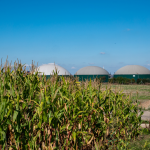Do you know the types and characteristics of nanofertilizers?
In the world of modern agriculture, the search for innovation is constant, with the aim of optimizing the use of resources, improving productivity and reducing environmental impact. In this context, nanofertilizers are presented as a revolutionary technology that offers innovative solutions for plant nutrition. These fertilizers, composed of nanoparticles that encapsulate essential nutrients for plants, are transforming the agricultural landscape with their multiple benefits and unique characteristics.
Types and characteristics of nanofertilizers: A diversity of solutions for plant nutrition
The diversity of nanofertilizers available on the market is based on two main aspects: the nanoparticle material and the encapsulated nutrient.
1. According to the nanoparticle material:
Inorganic nanoparticles:
- Metal oxides (ZnO, Fe2O3, CuO): Improve nutrient absorption and stress tolerance.
- Clays (montmorillonite, illite): They gradually release nutrients and control soil moisture.
- Mesoporous silicates: They increase the surface available for the adsorption of nutrients.
Organic nanoparticles:
- Biodegradable polymers (polylactone, chitosan): They protect nutrients from degradation and promote biocompatibility.
- Nanoemulsions (oils, lipids): They improve the solubility and penetration of nutrients into plant cells.
- Dendrimers: They allow a controlled and precise release of nutrients.
2. According to the encapsulated nutrient:
Macronutrients:
- Nitrogen (N): It is essential for the growth and development of plants.
- Phosphorus (P): Fundamental for photosynthesis and root formation.
- Potassium (K): Regulates the absorption of water and nutrients, and improves resistance to diseases.
Micronutrients:
- Boron (B): Essential for pollination and fruit formation.
- Iron (Fe): It is involved in photosynthesis and cellular respiration.
- Zinc (Zn): Essential for vegetative growth and seed production.
- Manganese (Mn): Participates in photosynthesis and nitrogen fixation.
- Copper (Cu): Important for photosynthesis and cellular respiration.
- Molybdenum (Mo): Essential for nitrogen fixation.
Biostimulants:
- Auxins: Promote the growth of roots and shoots.
- Gibberellins: Stimulate stem growth and flowering.
- Cytokinins: Regulate cell division and leaf development.
Nano fertilizers in agriculture
Unique advantages for more efficient agriculture with nanofertilizers
Nanofertilizers are distinguished by a series of characteristics that make them unique and advantageous compared to traditional fertilizers:
- Particle size: Nanoparticles are generally between 1 and 100 nanometers in size, which allows them to penetrate plant cells more efficiently, increasing nutrient absorption (link to a study demonstrating this). Although we also have them in a larger size of up to 600 nm, which have the advantage of ensuring no disruption of the cell membrane.
- Controlled release: Nanofertilizers can release nutrients in a gradual and controlled manner, reducing losses through leaching and volatilization (link to a study that demonstrates this), and optimizing nutrient availability for plants.
- Greater efficiency: The encapsulation of nutrients in nanoparticles improves the efficiency of their use by plants (link to a study that demonstrates this), allowing the necessary fertilizer doses to be reduced and minimizing the environmental impact.
- Nutrient protection: Nanoparticles protect nutrients from degradation by environmental factors such as sunlight, temperature and humidity, ensuring their stability and availability to plants (link to a study demonstrating this).
- Versatility: Nanofertilizers can be applied by different methods, including drip irrigation, foliar spraying and soil application (link to a study that demonstrates the effectiveness of each method), adapting to the specific needs of each crop.
Implications for agriculture:
The incorporation of nanofertilizers in agricultural practices offers several advantages:
- Increased productivity: Efficient use of nutrients by plants leads to increased crop growth and yield (link to a study demonstrating this).
- Reduced fertilizer use: Controlled release of nutrients minimizes the need for frequent fertilizer applications, reducing costs and environmental impact (link to a study demonstrating this).
- Improved soil health: Reduced nutrient leaching contributes to maintaining soil fertility and reducing nutrient pollution (link to a study demonstrating this).
- Sustainable agriculture: Nanofertilizers are positioned as a key tool for more sustainable, efficient and environmentally friendly agriculture (link to a study that demonstrates this).
Nanofertilizers: Challenges and opportunities
While nanofertilizers present enormous potential to transform agriculture, there are also some challenges that must be addressed for their widespread adoption:
- Cost and profitability: The production of nanofertilizers is still relatively expensive, which limits their accessibility to some farmers, especially in developing countries. The high production costs are due to the complexity of the nanoparticle synthesis and purification processes, as well as the need for specialized infrastructure. As technology advances and production scales, nanofertilizer costs are expected to reduce significantly. This will allow greater accessibility to farmers around the world, especially in developing countries. A clear example of success is the company Smallops.
- Research and development: While significant research has been done on nanofertilizers, more studies are still needed to better understand their long-term effects on the environment and human health. Additional research is required to evaluate the impact of nanofertilizers on soil quality, biodiversity and the food chain.
- Regulation: The lack of clear regulatory frameworks for nanofertilizers generates uncertainty in the market and makes their commercialization difficult. Regulations that establish safety, quality and labeling standards are needed to ensure the protection of consumers and the environment.
- Improved nutrient efficiency: Nanofertilizers offer greater nutrient use efficiency, meaning fewer amounts are required to achieve the same effect as traditional fertilizers. This reduces agricultural production costs and minimizes the environmental impact associated with nutrient leaching and volatilization.
- Sustainable agriculture: Nanofertilizers can contribute to more sustainable agriculture by reducing the use of traditional fertilizers, improving soil health and protecting water resources. Additionally, they can help mitigate climate change by reducing greenhouse gas emissions associated with agricultural production.
Despite these challenges, the opportunities offered by nanofertilizers are considerable. As technology advances and costs decrease, nanofertilizers have the potential to become an essential tool for more sustainable and productive agriculture, contributing to global food security.
An in-depth look at the nanoscale plant nutrition revolution
Nanofertilizers represent a revolution in plant nutrition, offering innovative solutions to optimize the use of resources, improve productivity and reduce the environmental impact in agriculture. Their unique characteristics, such as particle size, controlled nutrient release and nutrient protection, make them valuable tools for more sustainable and efficient agriculture. As research and development continues to advance, nanofertilizers have the potential to transform the agricultural landscape and contribute to global food security.
Are you looking for a naofertilizer? Contact us.




